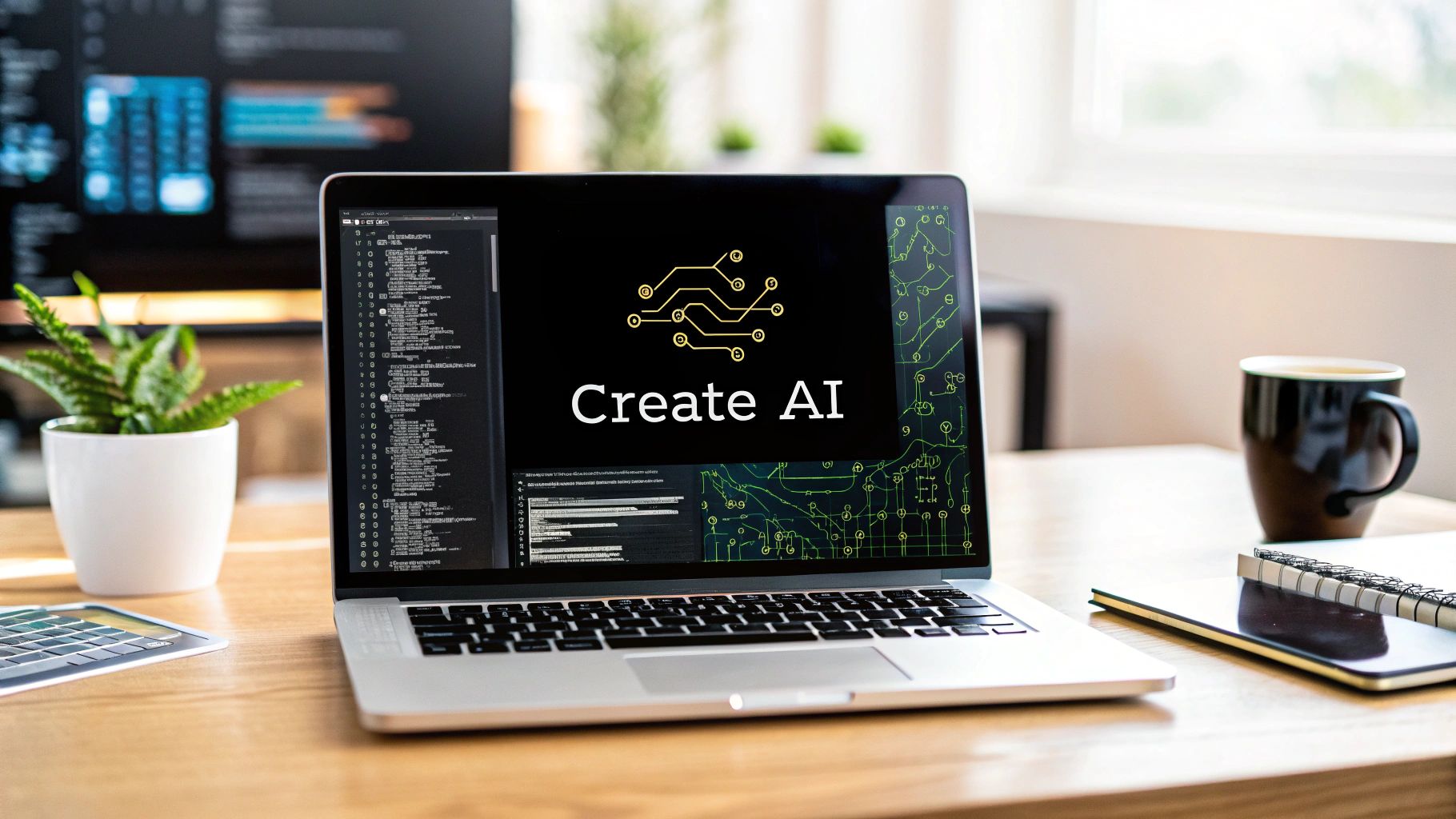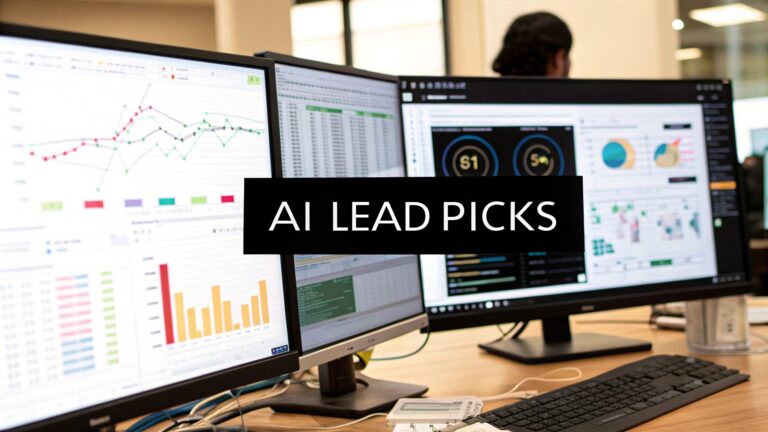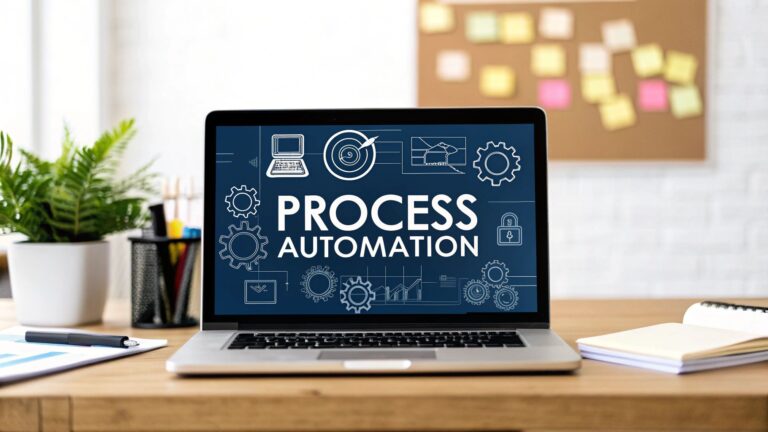How to Create an AI Program a Beginner’s Guide
Building an AI program isn't about conjuring up a sci-fi robot. At its core, it's a structured process: you start with a clear goal, get your data in order, pick the right tools, train a model, and then put it to work. This guide is here to walk you through that journey, step-by-step, turning a complex idea into a real-world solution.
Your First Steps in AI Program Creation
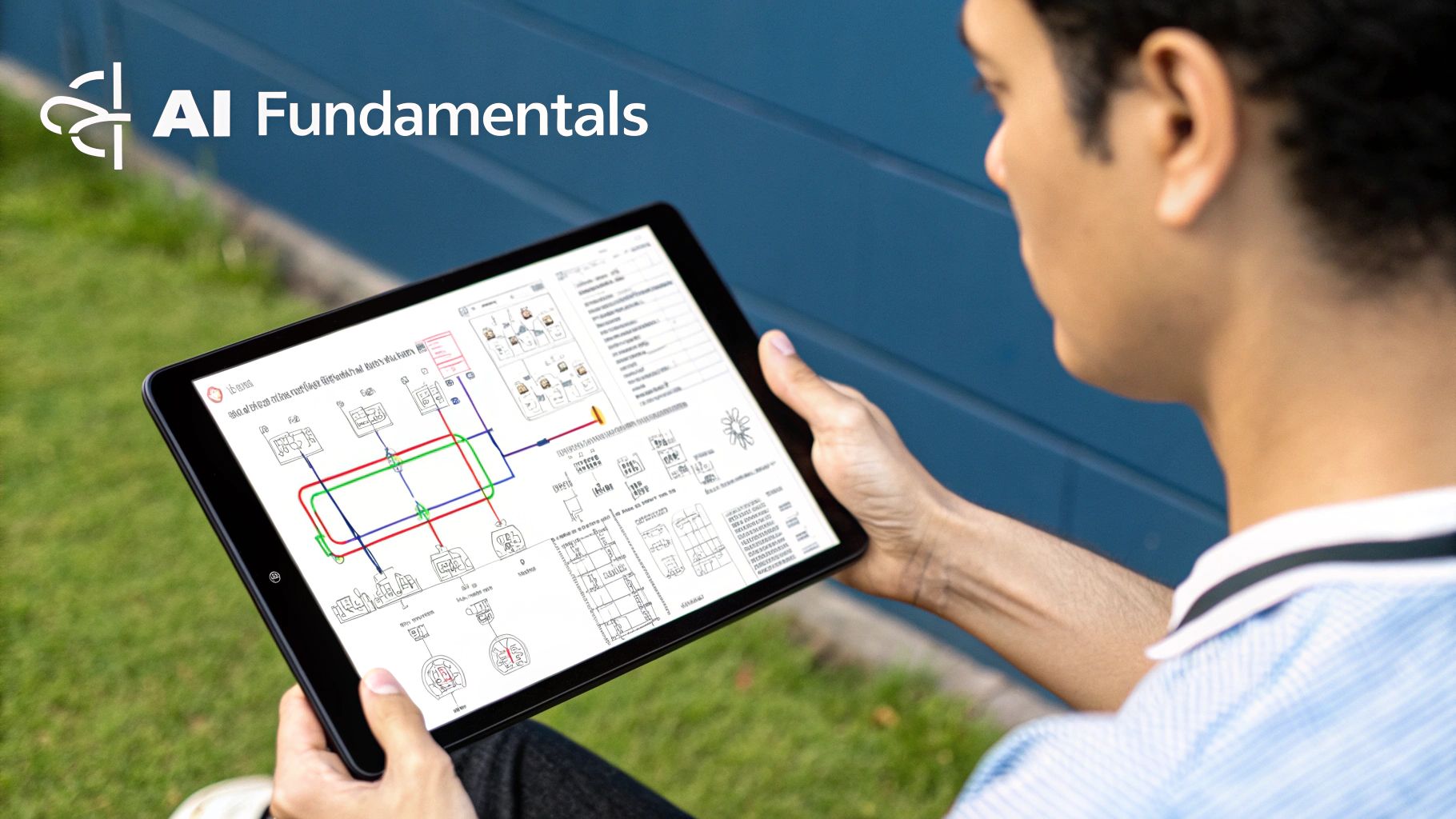
Jumping into your first AI project can feel intimidating, but the underlying concept is surprisingly straightforward. Think of it less as building a brain and more as training a specialist to solve one specific, measurable problem. That problem could be anything from predicting which customers are likely to cancel their subscriptions to filtering out spam or recommending the perfect next song.
The path from an idea to a functioning AI application follows a well-defined lifecycle. I’m going to lay out a practical roadmap that covers each essential stage, focusing not just on the "what" but the "why" behind each decision. With today's tools, you'll see that creating a powerful AI program is more accessible than you might think.
The Modern AI Workflow is a Team Sport
How we build software has fundamentally changed, and a big part of that is AI's role in the development process itself. It’s no longer just about writing code from scratch; developers now routinely team up with AI-powered tools to prototype ideas, hunt down bugs, and optimize performance.
Think about this: in 2024 alone, AI was credited with generating around 41% of all code on the planet. That's a staggering 256 billion lines of code in a single year. This isn't just a trend; it's a fundamental shift in how development gets done. Developers are now working alongside AI assistants, building better software, faster. So, as you learn to build an AI, you'll likely be using AI to help you do it.
The Core Lifecycle of Building an AI
Every AI project, from a simple chatbot to a complex image recognition system, moves through the same fundamental phases. Getting this flow down is the key to successfully bringing your concept to life.
-
Define Your Objective: You have to start with a razor-sharp goal. "Improve sales" is a wish, not a plan. "Build a recommendation engine to increase average cart value by 15%" is an actionable, measurable objective.
-
Source and Prepare Data: Data is the fuel for any AI model. This is where you'll spend a lot of your time—collecting, cleaning, and structuring the raw information your model will learn from. Garbage in, garbage out is the absolute rule here.
-
Select Your Tools: Next, you'll choose your workshop. This means picking the right programming language, like Python, and a framework that fits your problem, such as TensorFlow or PyTorch.
-
Train and Evaluate: This is the "learning" phase. You feed your prepared data to the model and let it find patterns. Afterward, you test it rigorously with new, unseen data to see how accurately it performs.
-
Deploy and Monitor: Once you're confident in its performance, you release your model into the wild where it can start doing its job. But it doesn't end there; you have to monitor its performance over time to make sure it stays accurate and effective.
As you get started, exploring the world of professional AI development services can provide a ton of insight, especially if your project starts to get more ambitious.
Defining a Clear AI Project Scope and Goal
Before you even think about writing a single line of code, let's talk about the single most important step in building an AI program: defining a sharp, specific goal. I’ve seen too many projects start with a vague ambition like "let's use AI to improve customer support." That's a recipe for a project that drags on forever and delivers nothing.
Think of it this way: a hazy goal leads to a meandering project with no clear finish line. You need a precise, measurable problem statement. Let’s take that customer support idea. A much stronger goal would be: "Develop an AI chatbot to resolve common tier-one support tickets, aiming to reduce human agent response times by 30% within six months." See the difference? Now you have a clear target.
This isn't just about paperwork; it's your strategic blueprint. A solid scope prevents wasted time and money and keeps the entire team pointed in the same direction. Your goal has to be tied to a real business outcome.
From Vague Idea to Actionable Plan
To get from a fuzzy idea to a solid project scope, you have to ask some tough questions. This is where you get brutally honest about what you're trying to achieve and what’s actually possible. It’s the process that ensures you’re solving a real problem, not just playing with cool tech.
First, pinpoint the specific pain point. Is your sales team drowning in manual data entry? Is customer churn through the roof? Once you know the problem, you can define what success looks like in cold, hard numbers.
- What’s the exact problem? Don't settle for "better lead scoring." Get specific: "Build a model that can predict which leads have an 80% or higher probability of converting."
- What data do you actually have? Your AI project is only as good as the data you feed it. Do you have enough of it? Is it clean? Is it relevant? This can make or break everything.
- How will you measure success? Define your Key Performance Indicators (KPIs) from day one. This might be a technical metric like model accuracy, but it’s even better if it’s a direct business metric like reduced operational costs. Our guide on what AI means for business can help you connect your project to tangible value.
A well-defined scope is your project's North Star. It guides every decision, from data collection to model deployment, ensuring that your final AI program delivers real, measurable impact rather than just becoming a technical exercise.
This kind of serious planning is becoming the norm. The global AI market was valued at around $391 billion in 2025 and is projected to skyrocket to $1.8 trillion by 2030. This isn’t just hype; it shows that building AI is now a core economic driver for companies of all sizes. You can find more data on AI's rapid market expansion on ExplodingTopics.com.
Choosing the Right Tools and Frameworks
Once you've nailed down a clear goal for your project, it's time to pick your toolkit. Stepping into the world of AI frameworks can feel a bit like walking into a massive hardware store for the first time—the options are endless. But here’s the good news: for most projects, especially if you're working in Python, the choice usually comes down to a few major players.
Making the right decision here is crucial. It’s not just about the code; it’s about development speed, the community you can lean on for help, and the long-term maintainability of your AI program.
Matching the Tool to the Task
Your first question shouldn't be "What's the most popular framework?" but rather, "What tool is built for my specific problem?"
For many classic machine learning tasks—like predicting sales figures from a spreadsheet or flagging emails as spam—you don't need to bring out the heavy artillery. A library like Scikit-learn is often the perfect fit. It’s built for efficiency with structured data and is famously user-friendly, which is why it's a go-to for both newcomers and seasoned pros.
This is a snapshot of the official Scikit-learn homepage, which gives you a great sense of its core strengths.
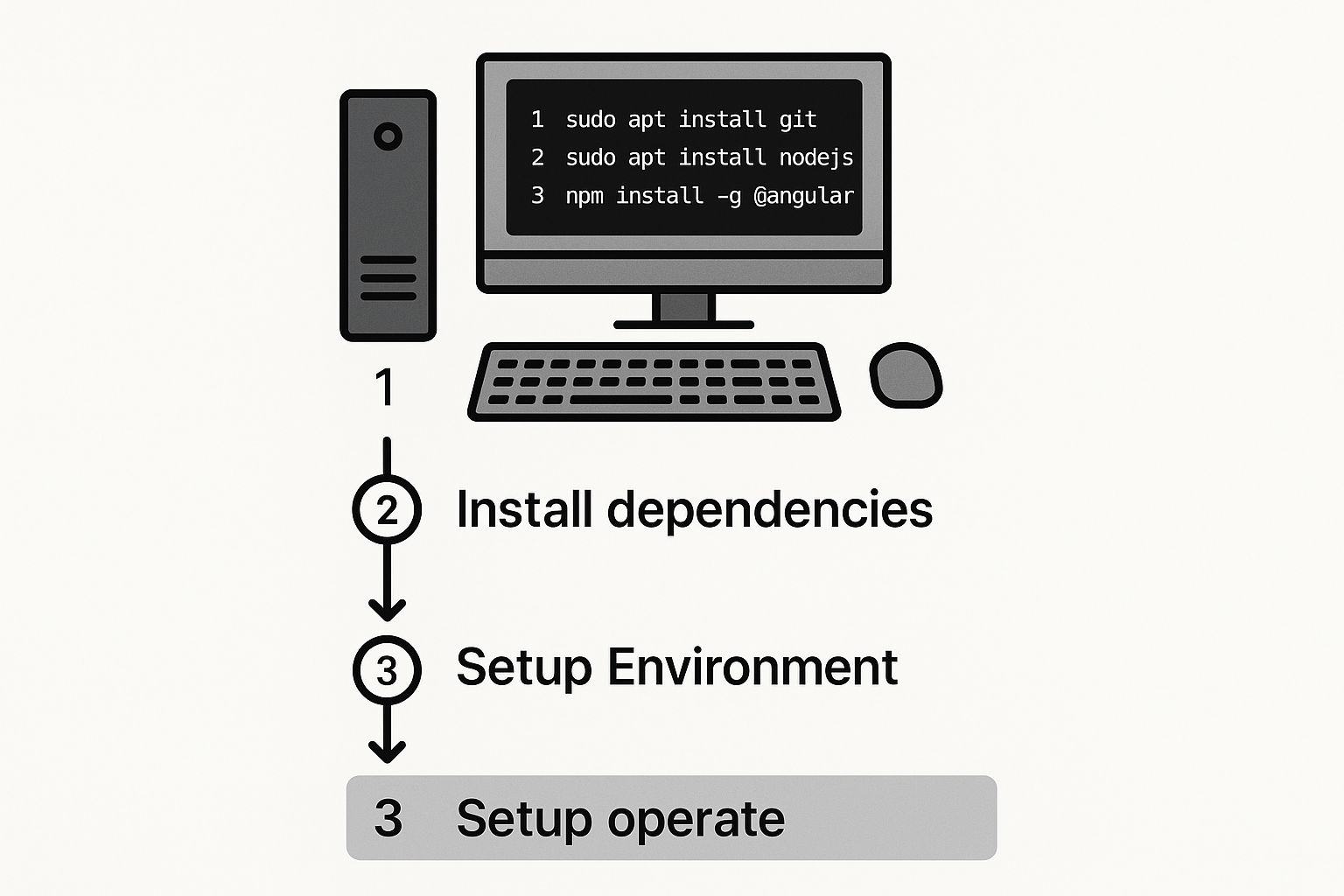
As you can see, it excels at the fundamentals: classification, regression, and clustering.
But what if your project involves deep learning? If you're working with complex, unstructured data like images, audio, or natural language, you'll need a framework with more horsepower. That’s where giants like TensorFlow and PyTorch enter the picture. They are designed from the ground up to handle the intense number-crunching required to train deep neural networks.
Choosing Your AI Programming Framework
To help you navigate this decision, here’s a quick comparison of the most popular Python libraries. Each has its own personality and strengths, so think about your project's needs and your own comfort level.
| Framework | Best For | Ease of Use (Beginner) | Key Feature |
|---|---|---|---|
| Scikit-learn | Traditional machine learning, data mining, and statistical modeling with structured data. | Very High | Its simple, consistent API makes it easy to implement dozens of algorithms with just a few lines of code. |
| TensorFlow | Production-ready, large-scale deep learning models, especially for image recognition and NLP. | Medium | Backed by Google, it offers a robust ecosystem (TensorFlow Extended) for deploying models in real-world applications. |
| PyTorch | Research, rapid prototyping, and flexible deep learning development. | High | Developed by Meta AI, its "Pythonic" feel and dynamic computation graphs make it intuitive for experimentation. |
So, what's the verdict? For anyone just starting out, Scikit-learn is a fantastic way to get your hands dirty with core ML concepts. Once you're comfortable there, making the leap to TensorFlow or PyTorch for more complex deep learning projects will feel much more natural.
Your choice of framework is a strategic one. While you can always pivot later, starting with the right tool saves an incredible amount of time and frustration. It lets you focus on building a great AI, not fighting your setup.
Preparing Your Data for Model Training
If you think of an AI model as an engine, then your data is the fuel that makes it run. This makes data preparation one of the most critical—and honestly, most time-consuming—parts of building any AI program. It's a classic case of "garbage in, garbage out."
You can have the most sophisticated algorithm in the world, but if you feed it messy, irrelevant, or incomplete data, you’ll get a terrible result. This isn't just about collecting data; it's a hands-on process of cleaning, structuring, and enriching it so the model can actually learn something useful. A surprising number of AI projects stumble right here, not because of a bad algorithm, but because the data simply wasn't ready.
Cleaning and Preprocessing Your Dataset
Let's be realistic: raw data is a mess. It's almost always riddled with errors, missing entries, and all sorts of inconsistencies that will confuse your algorithm and throw off its predictions. Your first task is to roll up your sleeves and clean it up.
This initial cleanup usually involves a few common tasks:
- Handling Missing Values: You'll find customer records without an age or purchase histories missing a date. You can't just leave these gaps. Depending on the situation, you might fill them with a mean or median value, or if a record has too many holes, you might have to remove it entirely.
- Correcting Inaccuracies: Typos are a fact of life. Your dataset might list "New York," "NY," and "new york city" as separate locations. It's on you to standardize these entries so your model sees them as the same thing.
- Dealing with Outliers: Imagine analyzing sales data where the average purchase is $50, but one entry is for $1,000,000. That single outlier can completely distort the model's understanding. You need to decide whether to remove it or use a statistical method to lessen its impact.
Data cleaning isn't just a tedious chore—it's the bedrock of your model's accuracy. A clean dataset ensures your AI learns from real patterns, not from random noise and errors.
The Art of Feature Engineering
With your data squeaky clean, you can get to the more creative part: feature engineering. This is where you transform raw data columns into new, more insightful features that help the model understand the underlying problem better. It’s where your own expertise about the subject matter really shines.
For example, a raw "customer sign-up date" isn't all that helpful on its own. But if you engineer a new feature like "customer tenure in days," you’ve suddenly created something far more valuable for predicting customer loyalty.
Similarly, you could combine "number of logins" and "last login date" to create a "user engagement score." It's these kinds of cleverly engineered features that often give you the biggest performance boosts.
Getting your data properly prepared and structured is a non-negotiable step, and a huge piece of that puzzle is knowing how to pull together different data sources. To get a better handle on this, check out our guide on data integration best practices for some more advanced strategies.
Training and Evaluating Your AI Model

Alright, you've cleaned your data and picked your framework. Now for the fun part: actually training the model. This is where the magic happens, where the AI starts sifting through the information you’ve fed it, trying to find the hidden patterns that will let it make smart predictions.
But hold on. You can't just throw all your data into the pot and hope for the best. The single most important step before you begin is to split your dataset. If you don't, your model might just memorize the data, which sounds good but means it will fall flat on its face when it sees anything new.
We typically break the data into three distinct piles:
- Training Set: This is the lion's share, usually 70-80% of your data. The model chews on this to learn and adjust.
- Validation Set: This is a smaller slice, maybe 10-15%. You'll use this during training to fine-tune the model's settings without giving it a peek at the final exam.
- Testing Set: The last 10-15% is locked away in a vault. The model never sees this during its education. It's used only at the very end for a completely unbiased grade on how it will perform in the real world.
Kicking Off the Training Process
With your data properly divided, it's time to pick an algorithm that fits your problem. If you're trying to predict a number—say, a house price—you might start with something straightforward like Linear Regression. But if you’re trying to teach it to recognize cats in photos, you'll need a heavier hitter, like a Convolutional Neural Network.
Training is really just a loop. You show the model the training data, it makes a guess, and you tell it how wrong it was. It then tweaks its internal knobs and dials to get a little closer to the right answer next time. Think of it as a student grinding through practice exams—each one makes them a little smarter.
Beyond Basic Accuracy: How to Tell if Your Model Actually Works
Once the training wheels are off, you bring out the testing set for the final exam. But how do you actually score it? Most people jump straight to accuracy—the percentage of correct predictions—but that metric can be incredibly deceptive.
Let's say you're building an AI to spot a rare disease that only 1% of people have. A lazy model could just predict "no disease" for everyone. It would be 99% accurate, right? But it would also be completely useless, failing to identify a single person who actually needs help.
This is exactly why experienced practitioners look at a richer set of metrics:
- Precision: When the model says "yes," how often is it right? This tells you about the quality of its positive predictions.
- Recall (or Sensitivity): Of all the people who actually had the disease, how many did the model catch? This shows how good it is at finding what matters.
- F1-Score: This is a neat little metric that combines precision and recall into a single number. It’s a great way to get a balanced view, especially when your data is lopsided like in our disease example.
A great AI model isn't just accurate; it's effective. Choosing the right evaluation metrics for your specific goal ensures you're building a program that solves a real problem, rather than just looking good on paper.
Getting this right is more important than ever. On new, tougher benchmarks, AI systems have shown massive performance gains, improving scores by 18.8 to 67.3 percentage points. This growing capability and trust in well-evaluated models is why the US FDA approved 223 AI-enabled medical devices in 2023, a staggering increase from just six in 2015. You can dig into more of these trends in the 2025 AI Index Report.
Getting Your AI Program Out Into the Wild
Building a powerful AI model is a fantastic achievement, but it’s only the first half of the journey. To get any real value from it, you have to get it out of your development environment and into the hands of users or other systems. This is where deployment comes in, and it's followed by the crucial, ongoing work of monitoring.
The most common way to do this is by wrapping your model in an Application Programming Interface (API). Don't let the term intimidate you. An API is just a standardized way for other software to talk to your model. It sends a request with new data, and your AI sends back a prediction. Python tools like Flask or FastAPI make this process surprisingly manageable.
Where Will Your AI Live?
Once your API is ready, you need to decide on its home. This choice really boils down to your budget, how much traffic you expect, and your team's technical skills.
Here are the usual suspects:
- Cloud Servers: Renting a virtual machine from a provider like AWS or Google Cloud is a common and flexible starting point. You get full control over the environment.
- Containers: This is a modern favorite for a reason. Tools like Docker package your AI program and everything it needs to run into a single, tidy "container." This means it will work exactly the same way on your laptop as it does in production. No more "but it worked on my machine!" headaches.
- Serverless: If your model only needs to make predictions occasionally, a serverless setup can be a huge money-saver. You only pay for the exact moments your code is running.
The real aim of deployment isn't just to switch the model "on." It's about building a reliable and scalable service. Your strategy should ensure the AI can handle the pressure of real-world use without breaking a sweat.
Why the Work Isn't Over After Launch
Hitting the "deploy" button is a milestone, not a finish line. The world is constantly changing, and so is the data your model sees. Over time, its performance will inevitably degrade—a phenomenon we call model drift.
Think about a fraud detection model trained on data from 2023. It won't know how to spot the new, clever scams that pop up in 2025. That's model drift in a nutshell.
This is exactly why you can't just launch and forget. Constant monitoring is non-negotiable. You have to keep a close eye on your model's accuracy and other performance metrics. When you see them start to dip, that's your cue to retrain the model with fresh data to keep it sharp and relevant.
For a deeper look at how AI fits into day-to-day operations, our guide on leveraging AI for business automation has some great practical advice.
Common Questions About Creating an AI Program
https://www.youtube.com/embed/uxE8FFiu_UQ
Diving into your first AI project can feel a bit overwhelming, and it's natural for questions to pop up. Let's walk through some of the most common ones I hear from people just getting started.
How Much Math Do I Really Need to Know?
This is probably the number one question on everyone's mind. The honest answer? It depends on what you want to do.
If your goal is to invent brand-new algorithms from scratch, then yes, a deep dive into linear algebra, calculus, and probability theory is non-negotiable. But for most of us building practical AI applications, you don't need a Ph.D. in mathematics.
Modern frameworks like TensorFlow and Scikit-learn do the heavy lifting for you, handling all the complex number-crunching under the hood. Your job shifts from being a mathematician to being a skilled practitioner.
Think of it this way: you need to be a great mechanic, not the engineer who designed the engine. You need to know which tool to grab for a specific problem and how to tune it perfectly to get the best performance.
The focus is on understanding the concepts—knowing what a particular model is trying to accomplish and how to tell if it's actually doing a good job.
Can I Create an AI Program Without a Lot of Data?
The short answer is: sometimes. It really hinges on the complexity of your problem.
Deep learning models, especially for things like high-resolution image or video analysis, are notoriously data-hungry. They often need massive, diverse datasets to learn effectively and avoid making silly mistakes.
But for many classic machine learning tasks, you can get surprisingly good results with a smaller, well-curated dataset. The key here is quality over quantity.
A fantastic technique called transfer learning also completely changes the game. It allows you to take a model that's already been trained on a huge dataset (like images from across the internet) and fine-tune it for your specific task. This gives you a massive head start without needing to collect terabytes of data yourself.
Ready to implement AI and automation without the steep learning curve? MakeAutomation specializes in building custom AI-powered workflows that eliminate manual tasks and scale your business. Find out how we can help you at https://makeautomation.co.

